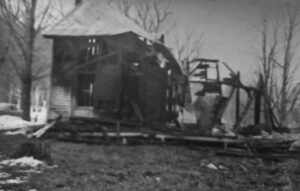A Piece of Galway History for Sale: The Story of Cummings Pond
By Dave Waite
Nestled just west of the Galway village crossroads is Cummings Pond, a beautiful, peaceful park with close connections to Galway’s social and natural history. The plot, which has seen a parade of owners, is once again for sale. By shedding light on the property’s past, I hope to inspire Galway officials to purchase and preserve the parcel for the enjoyment of future generations.
In 1905, the Cummings family dammed Glowegee Creek, which flooded the wetlands and created a small body of water. As was typical, the family gave the pond its name. To this day, Glowegee Creek flows east from Cummings Pond through the town of Galway. It then continues across Saratoga County, where it empties into the Hudson River by way of Kayaderosseras Creek.
The history of the Glowegee area, however, predates the Cummings family by over 100 years. Through my extensive investigations in the Saratoga County Clerk’s Office, I located Asa Kellogg as the first recorded property owner of the Glowegee wetlands, way back in mid-18th century.
Asa, born in 1745, was the son of Deacon Silas and Ruth (Root) Kellogg of Sheffield, Massachusetts. He settled in Galway, in Saratoga County, about the time of the Revolution, and, like most men of his generation, he was a farmer. Esteemed by his neighbors, he was elected captain of the militia, justice of the peace, and deacon in the First Presbyterian Church of Galway. During the war for independence, Asa served as a sergeant in Captain Enoch Noble’s company, which was part of the regiment led by Col. John Brown. In 1766, three years after the war, he married Lucy Powell, with whom he sired a brood of ten children. During the War of 1812, he served as a major in Saratoga County’s 24th Regiment. Lucy died on November 9, 1816, and Asa passed four years later, on June 4, 1820. Both are buried in Galway’s Stimson Cemetery, which sits only a short distance south of the pond, on the east side of Consaul Road.
Before Asa died, however, his son Ezra purchased the property from his father for $500 in April 1801. About that time, a house was constructed on the plot, though it is unknown if the builder was Ezra or his father. The Kellogg house sat close to the intersection of what is now West Galway and Consaul Roads, a place that in later years would be known as Cummings Corners. It was a large, two-story center hall federal-style colonial house with a cellar under at least a portion of the structure. Later owners remembered it as a lovely home with five bedrooms and a brick-faced fireplace and Dutch chimney. At some point in its early history, a one-story structure was added to the rear, giving the house an “L” shape. The main entrance of the building faced east, while the south side, with its a chimney, faced West Galway Road. Moreover, there were two outbuildings: a carriage house and stable that remain to this day; and an unidentified building just to the west of the carriage house which collapsed upon itself in the 1950s.
Ezra Kellogg and his wife Abigail Olmstead Kellogg had nine children. Their first, Ezra Powell Kellogg, arrived in 1795. Ezra Jr. became a boot and shoemaker in the village of Galway, and, like his grandfather, was an active member of the community. In 1823, he married Margaret Anderson, the daughter of Henry and Elizabeth Heggie Anderson of Scotland. In 1838, he signed the petition to have Galway made an incorporated village. Ezra Jr. and Margaret resided at the Kellogg homestead, yet they never officially owned it. Ezra Jr. died on April 11, 1867, and one year later, the heirs of Ezra Sr. and Abigail, including Margaret, sold the property and house that would become the Cummings homestead for $4000, to Galway residents John M. Smealie and Flavel Shattuck. Without a husband or a home, Margaret relocated to New York City to be with her son Montgomery. She died there two years later, but she is buried in Galway Village Cemetery.
Smealie and Shattuck were experienced farmers. Indeed, twenty years prior to purchasing the Kellogg property, they both won awards in a plowing competition at the 1847 Annual Fair and Cattle Show of the New York State Agricultural Society, held in Saratoga Springs. Shattuck won the $15 first place out of fourteen plowmen, and Smealie took second and $12. Nevertheless, their interest in the estate was purely profit: they immediately resold it, for $3500, to Sarah J. Preston.
Sarah J. Preston was the second wife of Dr. Calvin Preston, MD, an 1824 graduate of Fairfield Medical College in Herkimer County, New York. He moved his family of nine children to Galway in 1830, where he built a four-bedroom house in the village that doubled as his medical office. It is likely that they only used the Kellogg homestead as a summer escape.
Dr. Preston practiced medicine until 1877. When he died eight years later, the land and house were next sold, in August 1889, to Lucretia W. Lounsberry of San Antonio, Texas for $2500 cash and a mortgage of $1500 held by previous owners, Smealie and Shattuck. The mortgage was to be paid immediately, and Lounsberry was also required to honor a lease that George Turner had on the property that would expire the following April. Lounsbery was the sister of Sarah Cummings, whose husband, William H. Cummings, purchased the property in 1906 from Lucretia. William Cummings operated the Cummings Car Works, which manufactured railroad cars in Jersey City, New Jersey.
It is through Sarah that we find the connection between Galway and the Cummings Family. Sarah and her sister were the daughters of Selah Otis Durkee and Sarah C. Meeker, residents of the city of Schenectady. Selah was the son of Galway resident Pilgrim Durkee, who was a quartermaster in Saratoga County’s 24th Regiment during the War of 1812, at the same time as Ezra Kellogg was a captain in the regiment. Tragically, William Cummings died only two years after purchasing the property. On November 12, 1908, William and Anna Cummings, Edward and May Cummings, and Harold and Edith Cummings of Jersey City, New Jersey, heirs of William H. Cummings, deeded the property to Sarah Meeker Cummings, William’s widow.
A few years after creating Cummings Pond, the family raised the level of the dam to increase the surface area and depth. Due to this change in the water level, the adjacent property was flooded. In 1910, Stephen and Maggie Brown of Galway sold to Sarah Cummings acreage on the north side of the highway leading from Cummings’ Corners to West Galway. It was said to be nearly in the center of the twenty-eight-acre parcel, and the acreage could vary between five or six acres, depending on the depth of the water. The Browns reserved all the wood on the land, as well as free access on or through the property. The deed also stipulated that if the Cummings family later increased the height of the dam, further compensation was expected.
Three generations of the Cummings family used the Kellogg homestead as a summer residence during the years they owned the property. At first, they traveled by train from New Jersey to Amsterdam, and then by stage to Galway. Later, they traveled there in a Pierce-Arrow automobile. Everett Bunn, who lived adjacent to the pond, tells of being thrilled to go for a drive in that classic car. The family canoed and rowed boats on the pond, while the men fished in the spring and hunted ducks in the fall. In the winter, the Cummings’s and their neighbors used the pond for ice. When unoccupied, Mrs. George “Mattie” Eaton served as caretaker. The property stayed in the Cummings family until it was sold to Henry L. & Verna Bejian in 1956.
The Bejians went right to work improving the estate. That same year, Henry hired Lou Hersey and his son to deepen the pond. Using a bulldozer, they removed fifteen inches of muck that over the years had settled on the bottom. In 1975, Henry Bejian wrote to Arlene Rhodes of the Galway Preservation Society about his time on Cummings Pond. He recalled that the house was, “a lovely old place with five bedrooms and an outhouse.” When he and his family took possession of the property, there were still pictures on the walls, cane furniture on the porches, and oak furnishings left by the previous owners. Many of these antiques are still held by his descendants.
In 1961, the Bejians sold the property to Daniel and Sue Salvante, who took up residence in the old summer home. Using resources from the pond, Daniel raised minnows to sell to local bait shops, then circulated the pond water through bathtubs that he kept in the shed. According to neighbor Bob Eaton, future plans included using the pond to raise trout. Those plans never came to fruition, as on March 13, 1964, while the Salvantes were away at work, a chimney fire wreaked havoc. A passing milkman noticed the smoke and flames and sounded the alarm, but by the time the fire department arrived, the house was a total loss. Hoping to rebuild, Daniel and Sue lived for a time in a trailer on the property, until finally deciding to sell it the following year.

The procession of owners continued over the next six years, until George and Shirley Lamb took possession in 1971 and held the property for sixteen years. Like their predecessors, they set about making improvements, including dredging the pond to allow water skiing (calling it “Shirley Lake”), and building a new house on the east side of the estate. When George retired from General Electric in 1987, they sold the land to a property development company.

Today, the only evidence of early activity along Cummings Pond is a large red shed with open bays and broken doors; weatherbeaten, neglected, and forlorn. A closer look inside reveals hand-hewn beams joined with wooden pegs with trees still covered with bark supporting the roof. This is evidence that the structure was built at a time before iron nails were common, or the lumber had been salvaged from an older building and moved to the site. The only sign of more recent activity is a few broken water skis left in the shed, and the bold letters “SHIRLEY LAKE” on the side facing the water.
Reminiscences of those who lived near the pond include a story of a time when caskets were stacked inside waiting for spring during the influenza epidemic of 1918. Memories of one lifelong resident even told of a one-story barracks for the troopers with a telegraph line for communication just west of the shed. All that remains at that spot today is a pile of wood slowly going back to the earth. On the right side of the shed that still stands is a small stable with two stalls, something that verifies that horses were kept there at one time.
Cummings Pond and its immediate environs is once again for sale. I hope that the town of Galway will seize the opportunity to develop the property into a park or nature preserve before it is lost forever to private hands. It would be a worthwhile achievement for the estate to continue to be a refuge for wildlife and a place where families of today and the generations of tomorrow could go for rest and recreation.
[Of published resources concerning Cummings Pond, the only resource that I located was the Galway Preservation Society’s book, Galway 1900-1949, which provided vital clues on the pond’s history. I was assisted in my research by Arlene Rhodes and Bruce Sanders of the Galway Preservation Society, as well as several others from the local community and the descendants of those who once owned the pond. Other sources for this article were online newspaper archives at www.fultonhistory.com and nyshistoricnewspapers.org, William Richard Cutter’s Genealogical and Family History of Western New York, Sylvester’s History of Saratoga County, and Transactions of the New York State Agricultural Society, Vol. VII.]
















